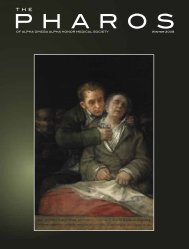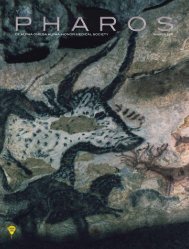The Pharos - Alpha Omega Alpha
The Pharos - Alpha Omega Alpha
The Pharos - Alpha Omega Alpha
Create successful ePaper yourself
Turn your PDF publications into a flip-book with our unique Google optimized e-Paper software.
<strong>The</strong> making of a neurosurgeon<br />
Cushing’s original illustration of the repair of a left-sided inguinal hernia, which he operated on at the same time as Halsted<br />
worked to repair a right-sided inguinal hernia on the patient. Labels from left to right and top to bottom read: “testicle,” split<br />
aponeurosis,” “thin fibers of int. oblique,” “upper limit of lower sac,” “cord showing [illegible] sac,” “opened lower sac.”<br />
Courtesy of the Medical Records Office and the Alan Mason Chesney Medical Archives of Johns Hopkins Institutions.<br />
Halsted had trained. 1,7 When Cushing returned to Baltimore<br />
in 1901, his future at Hopkins remained uncertain until the<br />
late fall, when he obtained an associate position within the<br />
hospital, and received Halsted’s blessing to pursue neurosurgery<br />
at least one day each week. Beginning in September 1901,<br />
Cushing expanded his surgical repertoire to include operative<br />
interventions for epilepsy, cerebral palsy, spina bifida, and<br />
trigeminal neuralgia. Even though these operations were a far<br />
cry from the general surgical procedures he had performed<br />
during his training with Halsted, Cushing’s neurosurgery at<br />
Hopkins owed a tremendous debt to the meticulous operative<br />
techniques he learned from Halsted.<br />
<strong>The</strong> personal and professional relationship between<br />
Cushing and Halsted was stormy at best, 1,9 but it cannot<br />
be doubted that Cushing had confidence in Halsted’s surgical<br />
practices; after all, Halsted had successfully removed<br />
Cushing’s appendix in 1897, following an episode of appendicitis.<br />
This faith in his mentor is perhaps underscored by<br />
the fact that, before his own bout with appendicitis, Cushing<br />
had performed an appendectomy on a patient who died after<br />
the operation. 9 Cushing thus understandably integrated the<br />
surgical and academic techniques of his mentor into his own<br />
practice.<br />
<strong>The</strong> importance Cushing placed on accurate wound approximation<br />
with minimal tension through the use of multilayered<br />
closures, an integral part of Halstedian technique, 6,7 is<br />
reflected in Cushing’s decision to use three to four layered closures<br />
in five of his ten operative interventions for the repair of<br />
spinal dysraphism. 12 <strong>The</strong> technique had been previously used<br />
in Europe, but did not become popular in the United States<br />
until 1918, following the publication of Charles Frazier’s book<br />
on operations of the spine. 14 <strong>The</strong> mortality rate for these patients<br />
remained high, but Cushing’s application of Halstedian<br />
principles led to long-term improvement in two patients 12 at a<br />
time when operating was considered largely futile.<br />
Cushing’s operative notes show his attention to hemostasis,<br />
albeit through somewhat unconventional means, as in a right<br />
subtemporal decompression from 1912:<br />
14 <strong>The</strong> <strong>Pharos</strong>/Autumn 2012














